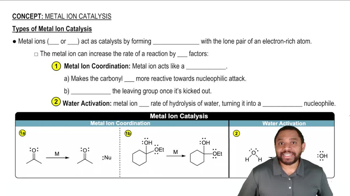Here are the essential concepts you must grasp in order to answer the question correctly.
Halonium Ion Mechanism
A halonium ion is a cyclic intermediate formed during the electrophilic addition of halogens to alkenes. This intermediate is characterized by a three-membered ring structure where a halogen atom is positively charged and bonded to two carbon atoms. The electrophilic nature of the halonium ion makes it susceptible to nucleophilic attack, typically at the more substituted carbon, leading to the formation of more stable products.
Recommended video:
Metal Ion Catalysis Concept 1
Nucleophilic Attack
Nucleophilic attack refers to the process where a nucleophile, which is an electron-rich species, donates a pair of electrons to an electrophile, forming a new bond. In the context of the halonium ion, a weak nucleophile attacks the carbon atom that bears a greater positive charge, which is often the more substituted carbon due to the stability of the resulting carbocation. This step is crucial for the conversion of alkenes to more complex organic molecules.
Recommended video:
Stereochemistry in Organic Reactions
Stereochemistry involves the study of the spatial arrangement of atoms in molecules and how this affects their chemical behavior. In synthetic conversions, the stereochemical outcome can influence the properties of the final product, such as its reactivity and biological activity. Understanding stereochemistry is essential when predicting the configuration of products formed during reactions, especially when dealing with chiral centers.
Recommended video:
Polymer Stereochemistry Concept 1
 Verified step by step guidance
Verified step by step guidance Verified video answer for a similar problem:
Verified video answer for a similar problem:



 1:44m
1:44m